Page 235 of 395

Your Honda is equipped with a
Traction Control System (TCS) to
assist you in maintaining traction
while driving slowly on loose or
slippery surf aces.
TCS monitors the speed of all f our
wheels. When it senses a f ront wheel
losing traction, it applies braking to
that wheel. The TCS Activation
indicator f lashes when this occurs.
Driving with TCS requires no special
skills or technique. The TCS does
not control your car’s whole braking
system and cannot prevent skidding
if you enter a corner too f ast. It is
still your responsibility to drive at
reasonable speeds and to leave a
suf f icient margin of saf ety.When starting out or driving on a
loose or slippery road surf ace, you
may notice that the car does not
respond to the accelerator in the
samewayitdoesatothertimes.This
is a sign TCS is activating. You will
seetheTCSActivationindicator
light f lash.TheTCSindicator(seepage )
comesonandstaysonwhenthereis
a problem with the TCS. The TCS
Activation indicator will also come on.
You should still install winter tires on
your car during the winter. Make
sure to use the same size originally
supplied with car. Exercise the same
cautioninwinterdrivingasyou
would if your car was not equipped
with TCS.
Driving with the compact spare tire
installed (see page ) may
activate the TCS. You should turn of f
the system.
60
334
On LX-V6 and EX-V6 models
Traction Control System
Driving232
TCS INDICATOR
TCS ACTIVATION INDICATOR
Page 244 of 395
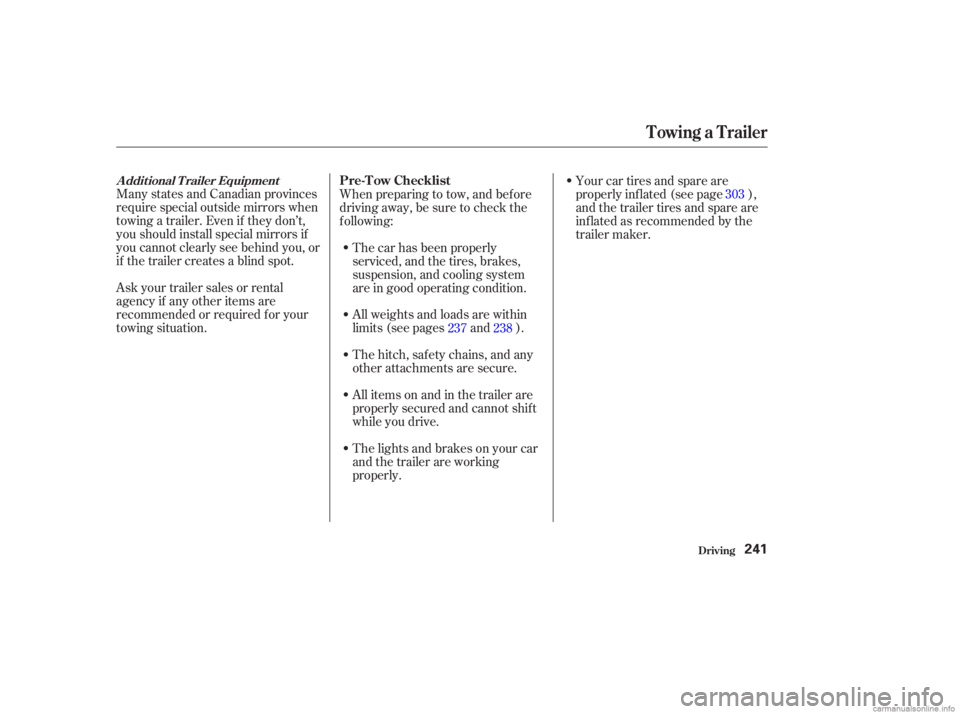
Many states and Canadian provinces
require special outside mirrors when
towing a trailer. Even if they don’t,
you should install special mirrors if
you cannot clearly see behind you, or
if the trailer creates a blind spot.
Askyourtrailersalesorrental
agency if any other items are
recommended or required f or your
towing situation.When preparing to tow, and bef ore
driving away, be sure to check the
f ollowing:
All weights and loads are within
limits (see pages and ).
Thehitch,safetychains,andany
other attachments are secure.
Allitemsonandinthetrailerare
properly secured and cannot shif t
while you drive. The car has been properly
serviced, and the tires, brakes,
suspension, and cooling system
are in good operating condition.
The lights and brakes on your car
and the trailer are working
properly. Your car tires and spare are
properly inf lated (see page ),
and the trailer tires and spare are
inflated as recommended by the
trailer maker.
237 238 303
Additional Trailer EquipmentPre-T ow Checklist
Towing a Trailer
Driving241
Page 306 of 395
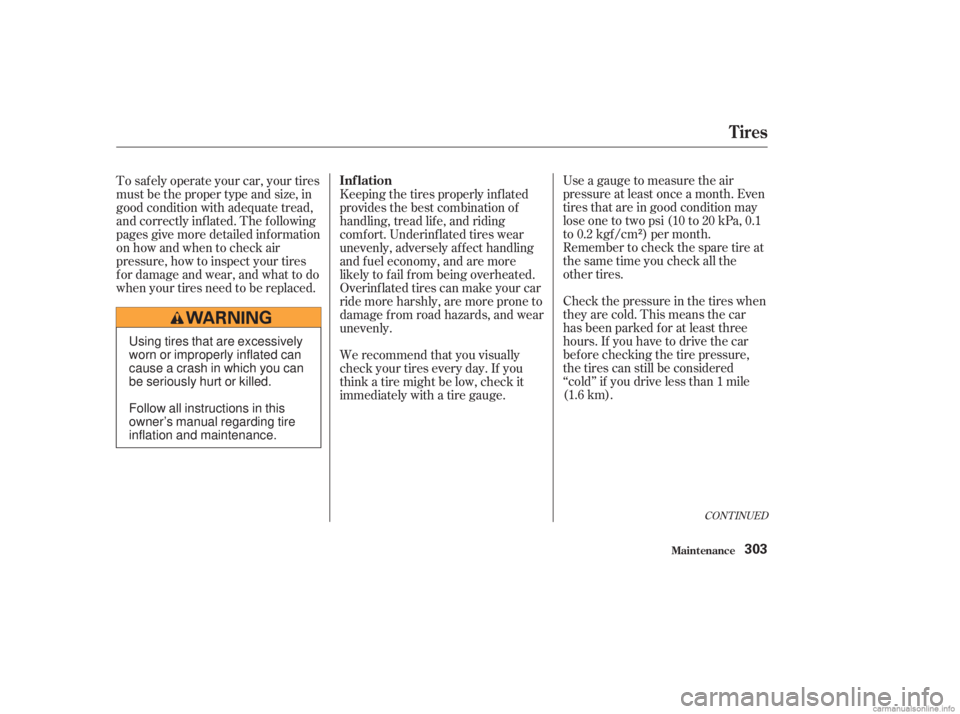
Use a gauge to measure the air
pressure at least once a month. Even
tires that are in good condition may
lose one to two psi (10 to 20 kPa, 0.1
to 0.2 kgf /cm ) per month.
Remember to check the spare tire at
thesametimeyoucheckallthe
other tires.
Check the pressure in the tires when
they are cold. This means the car
has been parked f or at least three
hours. If you have to drive the car
bef ore checking the tire pressure,
the tires can still be considered
‘‘cold’’ if you drive less than 1 mile
(1.6 km).
Keeping the tires properly inf lated
provides the best combination of
handling, tread lif e, and riding
comf ort. Underinf lated tires wear
unevenly, adversely af f ect handling
and f uel economy, and are more
likely to f ail f rom being overheated.
Overinf lated tires can make your car
ride more harshly, are more prone to
damage f rom road hazards, and wear
unevenly.
We recommend that you visually
check your tires every day. If you
think a tire might be low, check it
immediately with a tire gauge.
To saf ely operate your car, your tires
must be the proper type and size, in
good condition with adequate tread,
and correctly inf lated. The f ollowing
pages give more detailed inf ormation
on how and when to check air
pressure, how to inspect your tires
for damage and wear, and what to do
when your tires need to be replaced.
CONT INUED
Inf lation
Tires
Maint enance303
Using tires that are excessively
worn or improperly inflated can
cause a crash in which you can
be seriously hurt or killed.
Follow all instructions in this
owner’s manual regarding tire
inflation and maintenance.
Page 307 of 395
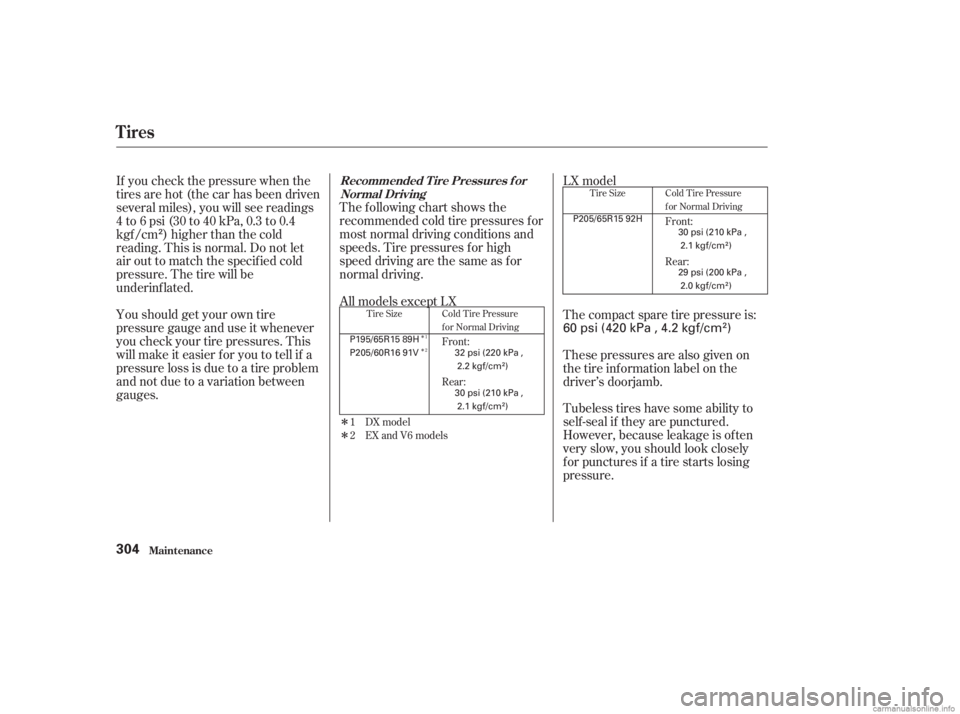
�Î
�Î
�Î
�Î
The following chart shows the
recommended cold tire pressures f or
most normal driving conditions and
speeds. Tire pressures f or high
speed driving are the same as f or
normal driving.
If you check the pressure when the
tires are hot (the car has been driven
several miles), you will see readings
4 to 6 psi (30 to 40 kPa, 0.3 to 0.4
kgf /cm ) higher than the cold
reading. This is normal. Do not let
air out to match the specified cold
pressure. The tire will be
underinf lated.
Youshouldgetyourowntire
pressure gauge and use it whenever
you check your tire pressures. This
will make it easier f or you to tell if a
pressure loss is due to a tire problem
and not due to a variation between
gauges.
Tubeless tires have some ability to
self -seal if they are punctured.
However, because leakage is of ten
very slow, you should look closely
for punctures if a tire starts losing
pressure. These pressures are also given on
thetireinformationlabelonthe
driver’s doorjamb. Thecompactsparetirepressureis: LX model
All models except LX
Tire Size Cold Tire Pressure for Normal Driving Tire Size Cold Tire Pressure
for Normal Driving
1
2DX model Front:
Rear: Front:
Rear:
EX and V6 models
1
2
Recommended T ire Pressures f or Normal Driving
Tires
Maint enance304
60 psi (420 kPa , 4.2 kgf/cm)
P205/65R15 92H
32 psi (220 kPa , 2.2 kgf/cm
)
30 psi (210 kPa , 2.1 kgf/cm
) 30 psi (210 kPa ,
2.1 kgf/cm
)
29 psi (200 kPa , 2.0 kgf/cm
)
P205/60R16 91V
P195/65R15 89H
Page 336 of 395

This section covers the more-
common problems that motorists
experience with their cars. It gives
you inf ormation about how to saf ely
evaluate the problem and what to do
to correct it. If the problem has
stranded you on the side of the road,
you may be able to get going again.
If not, you will also f ind instructions
on getting your car towed.......................
Compact Spare Tire .334
....................
Changing a Flat Tire .335
..........
If Your Engine Won’t Start . 340
Nothing Happens or the Starter Motor Operates ............................
Very Slowly .340
The Starter Operates ................................
Normally .341
................................
Jump Starting .342
............
If Your Engine Overheats . 345
.........
Low Oil Pressure Indicator . 347
..........
Charging System Indicator . 348
.......
Malf unction Indicator Lamp . 349
.......................
Readiness Codes .350
...............
Brake System Indicator . 351
..................
Closing the Moonroof . 352
..............................................
Fuses .353
..........
Checking and Replacing . 354
......................
Emergency Towing .358
Taking Care of the Unexpected
T aking Care of t he Unexpect ed333
Page 337 of 395
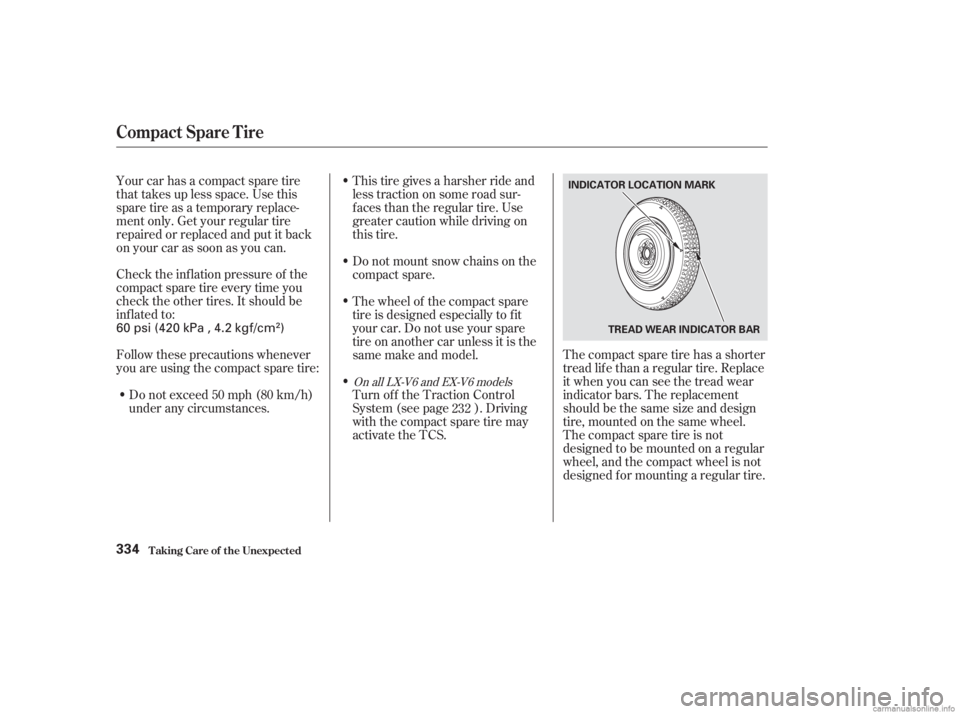
Thecompactsparetirehasashorter
tread lif e than a regular tire. Replace
it when you can see the tread wear
indicator bars. The replacement
should be the same size and design
tire, mounted on the same wheel.
Thecompactsparetireisnot
designed to be mounted on a regular
wheel, and the compact wheel is not
designed f or mounting a regular tire.
Check the inf lation pressure of the
compact spare tire every time you
check the other tires. It should be
inf lated to: Your car has a compact spare tire
that takes up less space. Use this
sparetireasatemporaryreplace-
ment only. Get your regular tire
repaired or replaced and put it back
on your car as soon as you can.
Follow these precautions whenever
you are using the compact spare tire:
Do not exceed 50 mph (80 km/h)
under any circumstances. This tire gives a harsher ride and
less traction on some road sur-
f aces than the regular tire. Use
greater caution while driving on
this tire.
Do not mount snow chains on the
compact spare.
Turn off the Traction Control
System (see page ). Driving
withthecompactsparetiremay
activate the TCS. The wheel of the compact spare
tire is designed especially to f it
your car. Do not use your spare
tire on another car unless it is the
same make and model.
232
On all LX-V6 and EX-V6 models
Compact Spare Tire
T aking Care of t he Unexpect ed334
INDICATOR LOCATION MARK
TREAD WEAR INDICATOR BAR
60 psi (420 kPa , 4.2 kgf/cm)
Page 338 of 395
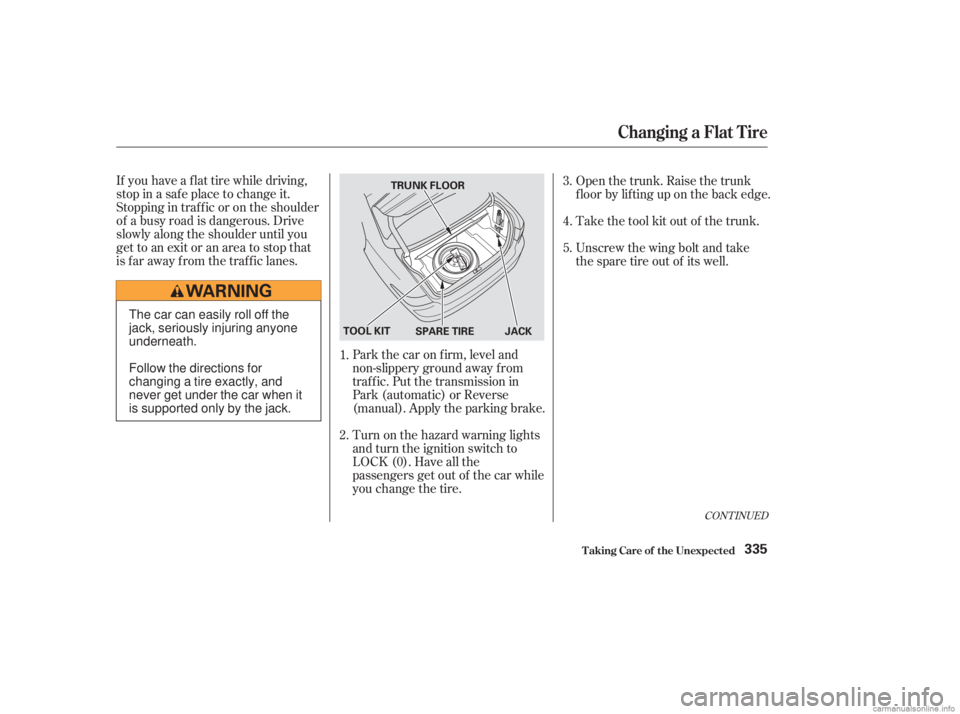
If you have a f lat tire while driving,
stop in a saf e place to change it.
Stopping in traf f ic or on the shoulder
of a busy road is dangerous. Drive
slowly along the shoulder until you
gettoanexitoranareatostopthat
is far away from the traffic lanes.Open the trunk. Raise the trunk
f loor by lif ting up on the back edge.
Park the car on f irm, level and
non-slippery ground away f rom
traffic. Put the transmission in
Park (automatic) or Reverse
(manual). Apply the parking brake.
Turn on the hazard warning lights
and turn the ignition switch to
LOCK (0). Have all the
passengers get out of the car while
you change the tire. Take the tool kit out of the trunk.
Unscrew the wing bolt and take
the spare tire out of its well.
5. 4.
3.
2. 1.
CONT INUED
Changing a Flat T ire
T aking Care of t he Unexpect ed335
TRUNK FLOOR
SPARE TIRE JACK
TOOL KIT
The car can easily roll off the
jack, seriously injuring anyone
underneath.
Follow the directions for
changing a tire exactly, and
never get under the car when it
is supported only by the jack.
Page 341 of 395
Put on the spare tire. Put the
wheel nuts back on f inger-tight,
then tighten them in a crisscross
pattern with the wheel wrench
until the wheel is f irmly against
the hub. Do not try to tighten
them f ully.
Bef ore mounting the spare tire,
wipeanydirtoff themounting
surface of the wheel and hub with
a clean cloth. Wipe the hub
carefully,itmaybehotfrom
driving.
Lowerthecartothegroundand
remove the jack.
12.
13.14.
T aking Care of t he Unexpect ed
Changing a Flat T ire
338
BRAKE HUB